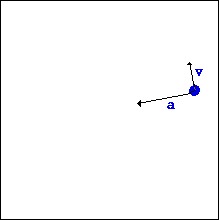Lecture 2 | Forces & Uniform Circular Motion
Newton's Laws 3
Lecture 2 | Forces & Uniform Circular Motion
Newton's Laws 3
Objects traveling in a circle at a constant speed are considered to be in uniform circular motion (UCM). Recall velocity has both magnitude and direction, so even though the magnitude of the tangential velocity remains the same in UCM, the direction is constantly changing. For this special case of motion the acceleration points towards the center of the circle which means the net force does as well.
Check out this trailer video from OpenStax about forces on objects in UCM.
Pre-lecture Study Resources
Read the BoxSand Introduction and watch the pre-lecture videos before doing the pre-lecture homework or attending class. If you have time, or would like more preparation, please read the OpenStax textbook and/or try the fundamental examples provided below.
Forces | Uniform Circular Motion
An object undergoes Uniform Circular Motion (UCM) when it moves around a circle of constant radius at a constant speed. When an object undergoes UCM its x and y components of position and velocity are always changing. This makes them more difficult to deal with than, if instead, we choose the direction pointing towards the center of the circle. The radial direction, and the direction that points around the circle, called the tangential direction, provide a simplification in the analysis. Objects undergoing UCM have a net force pointing towards the center of the circle - entirely in the radial direction. The acceleration is also thus in the radial direction, according to Newton's 2nd Law, and is equal to ar=v2r, where v is the speed and r is the radius.
OpenStax Section 6.3 | Centripetal Force
Warning: careful consideration must be made when using the term centripetal force, as it implies an actual force, separate from others, in the radial direction. The term centripetal is referring to the net effect of all the real forces when an object is in UCM. In the case of UCM the net force is in the radial direction and that net force (from real forces) is called the centripetal force. Often students will describe a centripetal force as a source rather than a description of the phenomena, to avoid this make sure to describe what type of force is causing the centripetal force i.e. a normal force on a roller coaster, a friction force between a car and a race track etc.
OpenStax Section 6.4 | Fictitious Forces and Non-inertial Frames: The Coriolis Force

